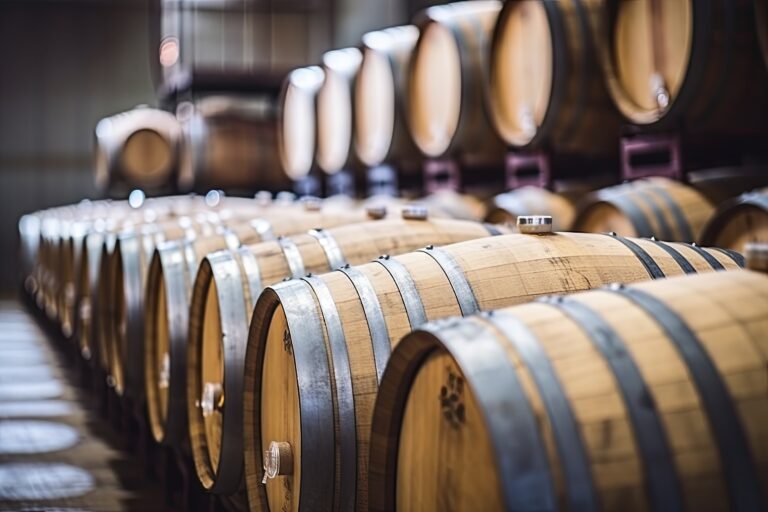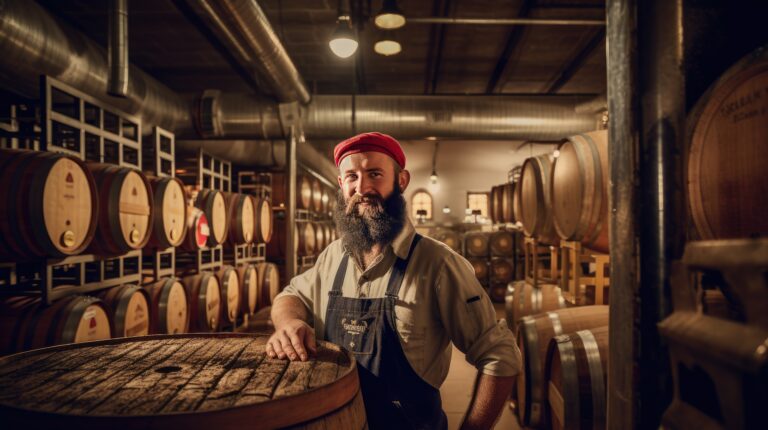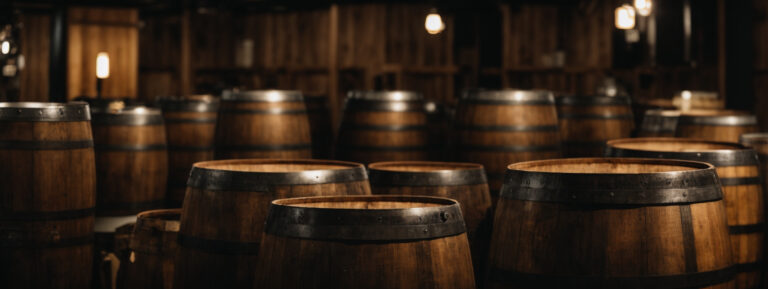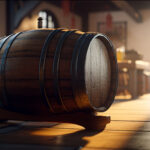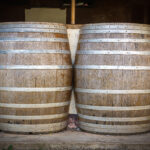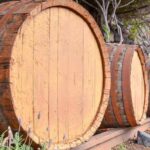Imagine a universe devoid of the amber glow of aged whiskey, a cosmos where the intricate dance of vanilla, spice, and smoke never graced the palate. A barren expanse, a testament to the profound absence of the humble oak barrel. Let us embark on an odyssey of epic proportions, a pilgrimage into the very heart of whiskey maturation, where we unravel the sacred mysteries of the oak barrel, the alchemist’s crucible, the cosmic womb where spirit is reborn, transformed, and transcended.
Oak’s Eternal Reign and the Symphony of Terroir’s Whispers
For eons, oak has reigned as the undisputed deity of whiskey barrel construction, a testament to its unparalleled properties and the profound influence it bestows upon the spirit within, a silent sentinel witnessing the passage of time.
- American White Oak (Quercus alba): Sourced from the verdant forests of Missouri, Kentucky, and Tennessee, this oak is a veritable treasure trove of vanillin, the compound responsible for those celestial sweet, creamy vanilla notes, a gift from the earth itself. Its tight grain, a testament to its slow, deliberate growth in temperate climates, ensures a gradual and nuanced release of flavors, a patient unfolding of aromatic secrets, a slow and steady revelation. The meticulous process of air-drying, spanning two, three, or even more years, is a ritual of purification, reducing moisture and mellowing tannins, preventing unwanted harshness from permeating the whiskey’s soul, a delicate process. The specific region, the specific forest, the specific tree, all contribute their own unique chemical signature, a testament to the power of place. The levels of cis- and trans-oak lactones are affected by the drying process, and the specific location the oak is grown.
- European Oak (Quercus robur, Quercus petraea, Quercus sessiliflora): Originating from the ancient forests of France, Spain, and Eastern Europe, these oaks are more porous and tannic, contributing a richer, spicier, and sometimes smokier character, a testament to the diverse terroir from which they spring, a reflection of the varied landscapes. French oak, in particular, is revered for its ability to impart elegant and nuanced flavors, often used for premium spirits, where subtlety and complexity are paramount, a testament to the French tradition of refinement. Each species of European oak, and even the specific forest in which it thrives, imparts unique chemical compounds, a reflection of the soil, climate, and microflora that shaped its growth, a testament to the power of ecosystems. The specific levels of ellagitannins, and other extractives change based on the forest, and the coopering process.
The construction of these barrels is a testament to the cooper’s divine artistry, a craft passed down through generations like a sacred lineage, a tradition as old as time itself. Coopers, master artisans, meticulously select and shape oak staves, heating and bending them to form the iconic barrel shape, a vessel of transformation, a symbol of craftsmanship. The staves are then fitted together with unwavering precision, a testament to their skill, and secured with metal or wooden hoops, binding the vessel together, a physical manifestation of unity.
Toasting and Charring as Ritual Transformation and Chemical Unleashing
The transformative power of the barrel is unlocked through the sacred rituals of toasting and charring, processes that unleash the oak’s hidden potential, revealing its innermost secrets, a dance of fire and wood.
- Charring: This fiery ritual involves exposing the barrel’s interior to a controlled flame, a dance of fire and wood that creates a layer of charred wood, a blackened canvas upon which the spirit will paint its masterpiece, a catalyst for chemical reactions. This process caramelizes wood sugars, releasing a symphony of aromatic compounds, including vanillin, guaiacol (smoky notes), and furfural (almond and caramel), each contributing to the spirit’s complex character, a testament to the power of pyrolysis. The level of char, ranging from light to heavy, dictates the intensity of flavor imparted, a choice that reflects the distiller’s vision, a deliberate act of creation. Bourbon barrels, for example, undergo heavy charring, contributing to their distinctive smoky-sweet character, a testament to the American tradition, and the increased levels of phenolic aldehydes.
- Toasting: A gentler ritual involving dry heat, toasting caramelizes wood sugars and releases aromatic compounds without creating a charred layer, a subtle coaxing of the wood’s inherent flavors, a gentle persuasion. Light toasting imparts subtle nuances, while heavy toasting releases more intense notes of vanilla, caramel, and spice, a reflection of the distiller’s desired profile, a carefully orchestrated performance. Scotch barrels often undergo toasting, allowing the spirit’s delicate flavors to shine, a testament to the Scottish art of balance, and the preservation of the spirit’s base notes. The Maillard reactions are controlled by the time and temperature.
The Historical Evolution of Barrel Aging Through the Ages and Civilizations
The use of oak barrels for storing and transporting liquids dates back to ancient civilizations, but the realization of their transformative power on spirits emerged gradually, a serendipitous discovery that shaped the course of whiskey history, a testament to the interplay of chance and observation, and the evolution of human understanding.
Initially, barrels served practical purposes, but as whiskey was stored for longer periods, distillers observed a remarkable metamorphosis, a transformation from raw spirit to refined elixir, a revelation. The harsh, raw flavors of new-make spirit mellowed, and the spirit acquired a richer color and complex aroma, a testament to the alchemy of time and wood, and the slow working of nature. This accidental discovery led to the intentional aging of whiskey in oak barrels, a practice that has become an art form, a science, and a tradition, a testament to human ingenuity, and the pursuit of perfection.
Oak and Whiskey’s Intricate Dance of Chemical Reactions and Physical Exchange
The interaction between oak and whiskey is a complex interplay of extraction, oxidation, filtration, and evaporation, a delicate dance that shapes the spirit’s character, a testament to the symbiotic relationship between wood and liquid, and the interplay of physical and chemical processes.
- Extraction: Whiskey extracts flavor compounds from the oak, including vanillin, lactones (coconut and fruity notes), and tannins (bitterness and astringency), each contributing to the spirit’s complex profile, a testament to the power of dissolution. The specific compounds extracted are determined by the species of oak, the level of toasting or charring, and the age of the barrel, a testament to the interplay of variables, and the dynamic nature of the process. The rate of extraction is controlled by the proof of the spirit, and the temperature of the aging warehouse.
- Oxidation: Oxygen, entering through the porous oak, reacts with compounds in the whiskey, mellowing harsh flavors and developing complexity, a testament to the slow and controlled transformation, and the power of oxidative reactions. This gradual oxidation is essential for the maturation process, a testament to the passage of time, and the subtle changes that occur.
- Filtration: The charred layer of wood acts as a filter, removing unwanted congeners and impurities, contributing to the spirit’s clarity and smoothness, a testament to the wood’s purifying power, and the adsorption properties of carbon.
- Evaporation: A portion of the whiskey evaporates through the oak, known as the “angel’s share,” concentrating the remaining flavors and contributing to the spirit’s richness, a testament to the ephemeral nature of existence, and the vapor pressure of alcohol.
Expanding the Palette with Diverse Casks and the Influence of Previous Contents
While oak remains the foundation, distillers are increasingly experimenting with diverse cask finishes to add layers of complexity to their whiskeys, creating a symphony of flavors, a testament to human creativity, and the influence of previous users of the barrel.
- Sherry Casks: Impart notes of dried fruit, nuts, and spice, creating a rich and complex profile, a testament to the Spanish tradition, and the residual sugars and compounds from the sherry.
- Port Casks: Contribute flavors of berry, raisin, and chocolate, adding a sweet and fruity dimension, a testament to the Portuguese tradition, and the influence of the fortified wine.
- Rum Casks: Add tropical notes of banana, pineapple, and coconut, creating a vibrant and exotic character, a testament to the Caribbean tradition, and the residual esters and congeners from the rum.
- Wine Casks: Offer fruity and oaky nuances, depending on the wine type, creating a delicate and nuanced profile, a testament to the French tradition, and the influence of the specific varietals.
- Virgin Oak Casks: Impart intense oak, spice, and tannin flavors, creating a bold and robust character, a testament to the raw power of nature, and the unadulterated influence of new wood. The level of tannins extracted from virgin oak is higher than from used oak.
- Other Casks: Distillers are now experimenting with casks made from chestnut, acacia, and even cherry wood, each imparting unique flavor profiles, pushing the boundaries of whiskey maturation, and exploring new avenues of flavor.
Unraveling the Chemical Mysteries of Maturation and the Roles of Compounds
Whiskey maturation is a complex series of chemical reactions, a symphony of transformations driven by the interaction between the spirit and the oak, a testament to the power of chemistry, and the intricate dance of molecules.
- Esterification: Acids and alcohols react to form esters, contributing fruity and floral aromas, adding layers of complexity, a testament to the creation of new compounds, and the slow working of time. The formation of ethyl acetate, ethyl lactate, and other esters contributes to the fruity notes.
- Oxidation: Oxygen reacts with compounds in the whiskey, creating aldehydes and acids, which contribute to flavor complexity, shaping the spirit’s character, a testament to the power of change, and the subtle shifts in chemical composition. The oxidation of alcohols to aldehydes, and then to acids, changes the flavor profile.
- Hydrolysis: Water breaks down compounds in the oak, releasing flavor molecules, unlocking the wood’s secrets, a testament to the power of water, and the breaking of chemical bonds. The hydrolysis of hemicellulose releases sugars and other compounds.
- Extraction: Alcohol dissolves and extracts flavor compounds from the oak, creating the spirit’s signature profile, a testament to the power of dissolution, and the selective nature of solvents. The extraction of vanillin, lactones, and tannins contributes to the flavor and color.
- Furfural formation: The heating of wood during charring or toasting leads to the formation of furfural, which contributes to almond and caramel notes.
- Guaiacol formation: The breakdown of lignin during charring leads to the formation of guaiacol, which contributes to smoky notes.
- Tannin polymerization: Over time, tannins polymerize, which reduces their astringency and contributes to the smoothness of the whiskey.
Addressing the Inquisitive Soul’s Deepest Questions and Exploring the Nuances
- Why is oak the preferred wood? Its unique combination of density, flavor contribution, micro-oxygenation, and reusability makes it ideal, a testament to its inherent properties, and its suitability for the aging process. The tight grain prevents excessive leakage, and the porous nature allows for a controlled exchange of gases.
- What are the differences between American and European oak? American oak imparts sweeter, vanilla notes, while European oak contributes richer, spicier flavors, a testament to their diverse origins, and the varied chemical composition. The levels of vanillin and lactones are higher in American oak, while the levels of tannins are higher in European oak.
- How long do barrels last? Barrels are typically reused several times, with each use imparting a slightly different flavor profile, a testament to the cyclical nature of existence, and the gradual depletion of extractable compounds. The first fill barrels impart the most intense flavors, while subsequent fills impart more subtle nuances.
- What is the impact of warehouse location and climate? The temperature and humidity of the warehouse significantly impact the rate of maturation, a testament to the influence of environment, and the kinetic energy of molecules. Warmer temperatures accelerate the reactions, while higher humidity reduces evaporation. The location of the warehouse, and the airflow, also affect the aging process.
- What is the “angel’s share?” The “angel’s share” is the portion of whiskey that evaporates during aging, a testament to the ephemeral nature of existence, and the vapor pressure of alcohol and water. The rate of evaporation is affected by the temperature, humidity, and airflow of the warehouse.
- What are the legal requirements for whiskey aging? Legal requirements vary by region, but often specify the type of wood, the minimum aging time, and the maximum alcohol content for specific types of whiskey, a testament to the regulation of quality, and the preservation of tradition.
The Barrel’s Timeless Legacy and the Spirit’s Eternal Journey Through the Ages and Beyond
The oak barrel, a seemingly simple vessel, is a testament to the artistry, science, and tradition of whiskey making, a sacred grove where spirit is born anew, and a vessel of transformation. It’s a silent partner, a transformative chamber, where raw spirit is nurtured and refined, where time and wood conspire to create liquid poetry, a testament to the enduring power of nature and human ingenuity. The barrel is a symbol of patience, a testament to the slow and deliberate process of maturation, a reminder that some things are worth waiting for. The barrel is a vessel of history, a repository of flavors and aromas, a testament to the traditions and cultures that have shaped the world of whiskey. The barrel is a symbol of connection, a link between the past and the present, a reminder that we are all part of a larger story. And as the spirit ages, it takes on the character of the wood, the climate, and the passage of time, a testament to the interconnectedness of all things. The journey from raw spirit to aged whiskey is a metaphor for life itself, a process of transformation, growth, and refinement. And as we savor a dram of aged whiskey, we are not just tasting a spirit, we are tasting history, tradition, and the artistry of generations. We are tasting the essence of time itself.

